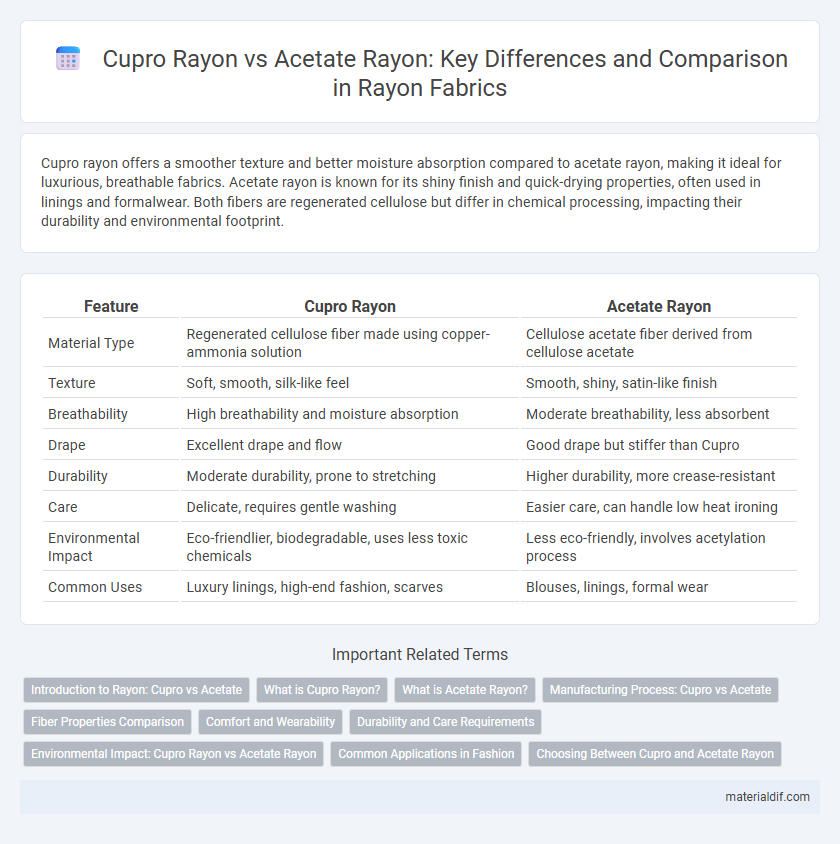Cupro rayon offers a smoother texture and better moisture absorption compared to acetate rayon, making it ideal for luxurious, breathable fabrics. Acetate rayon is known for its shiny finish and quick-drying properties, often used in linings and formalwear. Both fibers are regenerated cellulose but differ in chemical processing, impacting their durability and environmental footprint.
Table of Comparison
| Feature | Cupro Rayon | Acetate Rayon |
|---|---|---|
| Material Type | Regenerated cellulose fiber made using copper-ammonia solution | Cellulose acetate fiber derived from cellulose acetate |
| Texture | Soft, smooth, silk-like feel | Smooth, shiny, satin-like finish |
| Breathability | High breathability and moisture absorption | Moderate breathability, less absorbent |
| Drape | Excellent drape and flow | Good drape but stiffer than Cupro |
| Durability | Moderate durability, prone to stretching | Higher durability, more crease-resistant |
| Care | Delicate, requires gentle washing | Easier care, can handle low heat ironing |
| Environmental Impact | Eco-friendlier, biodegradable, uses less toxic chemicals | Less eco-friendly, involves acetylation process |
| Common Uses | Luxury linings, high-end fashion, scarves | Blouses, linings, formal wear |
Introduction to Rayon: Cupro vs Acetate
Cupro rayon, derived from cotton linter through cuprammonium process, offers a silk-like texture and exceptional breathability, making it ideal for luxury apparel. Acetate rayon, produced by acetylating cellulose, provides a glossy finish and vibrant dye retention, commonly used in linings and evening wear. Both fibers fall under regenerated cellulose rayon but differ in chemical composition and end-use applications.
What is Cupro Rayon?
Cupro Rayon, also known as cuprammonium rayon, is a regenerated cellulose fiber made by dissolving cotton linter in a copper-ammonia solution, resulting in a smooth, silky texture often used in luxury linings and delicate garments. Compared to acetate rayon, Cupro Rayon offers superior breathability, moisture absorption, and biodegradability due to its cellulose origin, making it a more environmentally friendly textile option. Its fine, soft fibers exhibit excellent dye affinity and a natural sheen, enhancing the aesthetic quality and comfort of clothing.
What is Acetate Rayon?
Acetate Rayon is a semi-synthetic fiber made from cellulose acetate, derived from wood pulp or cotton fibers, known for its silk-like appearance and smooth texture. It offers excellent drape and vibrant color retention, making it popular in linings, lingerie, and formal wear. Unlike Cupro Rayon, Acetate Rayon has lower moisture absorbency and can be more susceptible to heat damage during care.
Manufacturing Process: Cupro vs Acetate
Cupro rayon is produced through a unique process where cellulose from cotton linter is dissolved in a copper-ammonia solution, resulting in fine, smooth fibers ideal for luxury textiles. Acetate rayon manufacturing involves acetylating cellulose from wood pulp or cotton linter, which is then dissolved and regenerated to create fibers with a silky appearance but less breathability. The cupro process demands complex chemical handling and longer production times compared to the more straightforward acetylation and regeneration steps in acetate rayon fabrication.
Fiber Properties Comparison
Cupro rayon offers a silk-like sheen and superior breathability due to its fine fiber structure, enhancing moisture absorption and comfort. Acetate rayon, derived from cellulose acetate, provides a smooth texture with excellent drape but tends to have lower durability and reduced moisture absorbency compared to cupro. Both fibers exhibit excellent luster, yet cupro rayon's natural cellulose origin results in better biodegradability and overall fabric resilience.
Comfort and Wearability
Cupro rayon offers superior breathability and moisture absorption, making it ideal for comfort in warm climates and continuous wear. Acetate rayon, while smooth and lustrous, tends to retain more heat and is less effective in moisture-wicking, which can reduce comfort during extended use. The natural cellulose base of cupro provides enhanced softness and durability compared to the chemically modified acetate fibers.
Durability and Care Requirements
Cupro rayon exhibits higher durability due to its stronger fiber structure compared to acetate rayon, which is more prone to wear and tear. Care requirements for cupro involve gentle hand washing or dry cleaning to maintain fabric integrity, while acetate rayon demands more delicate handling, including avoiding high heat and harsh detergents. Both fibers benefit from air drying and low-temperature ironing to extend their lifespan and preserve appearance.
Environmental Impact: Cupro Rayon vs Acetate Rayon
Cupro rayon is produced from cotton linter, a byproduct of cotton processing, making it a more sustainable option with lower environmental impact compared to acetate rayon, which is derived from cellulose acetate often sourced from wood pulp. The manufacturing of cupro involves recycling and less chemical waste, while acetate rayon production releases significant acetyl compounds contributing to pollution. Cupro's biodegradability and use of renewable resources position it as an environmentally friendlier fabric option than acetate rayon.
Common Applications in Fashion
Cupro rayon is widely favored in luxury fashion for its silky texture and breathability, making it ideal for elegant blouses, linings, and dresses that require a smooth finish and comfort. Acetate rayon is commonly used in affordable fashion for linings, formalwear, and evening gowns due to its lustrous appearance and wrinkle-resistant properties. Both fibers contribute to diverse applications in clothing, with cupro offering a premium feel and acetate providing cost-effective aesthetic appeal.
Choosing Between Cupro and Acetate Rayon
Choosing between Cupro and Acetate Rayon depends on desired fabric qualities; Cupro offers a silky texture and superior breathability ideal for luxury garments, while Acetate Rayon provides vibrant colors and a glossy finish suitable for evening wear. Cupro is biodegradable and has moisture-wicking properties, making it more eco-friendly and comfortable in warm climates. Acetate Rayon, though less breathable, excels in wrinkle resistance and quick drying, favoring applications that require durability and ease of care.
Cupro Rayon vs Acetate Rayon Infographic

 materialdif.com
materialdif.com